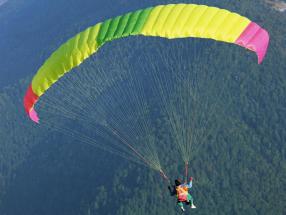Beginner Tips – Low U-Turn (part 1)
 Starting from the very first jumps, skydivers are taught that a low U-turn is one of the main causes of parachuting accidents. When turning, the vertical speed increases, and when exiting it, it goes into horizontal. One must be very careful in controlling the energy of the U-turn in order to avoid a collision with the ground. It doesn’t matter if the U-turn was the result of improvisation or a pre-planned maneuver, if contact with the surface occurs before the dome returns to normal, it can cause serious injury or death.
Starting from the very first jumps, skydivers are taught that a low U-turn is one of the main causes of parachuting accidents. When turning, the vertical speed increases, and when exiting it, it goes into horizontal. One must be very careful in controlling the energy of the U-turn in order to avoid a collision with the ground. It doesn’t matter if the U-turn was the result of improvisation or a pre-planned maneuver, if contact with the surface occurs before the dome returns to normal, it can cause serious injury or death.
Accidents are the result of two low turns. In the first case, an unplanned maneuver is an attempt to get away from an obstacle or other threat, often less serious (for example, landing in the wind). In the second, the U-turn is performed purposefully. Acceleration horizontally before landing, of course, is “high” for many skydivers, but they should be very familiar with the procedure for performing such turns, as well as with the consequences that may lead to an error in the calculation. And even skydivers conservative in terms of low U-turns should be aware of the order of their implementation in order to avoid the consequences of panic actions.
The design of any parachute wing follows simple principles. The slings of group A are shorter than the slings of group D, as a result of which the nose of the dome is lowered. The dome slides down like a sled from a mountain, the slope of which is determined by adjusting the length of the lines. Progressive forward movement contributes to the flow of air around the dome. The wing profile is set in such a way that the air pressure above the dome is lower than under it. The pressure difference creates lift. It is this lift that slows the rate of descent of the parachute-wing. Lifting power can also be created by deflecting the air flow down – we will discuss this effect when we talk about the angle of attack. The lifting force of both types depends on the square of the translational speed – when doubling the speed, the lifting force increases four times. At a speed of zero, the lifting force is zero! The ability of a wing to generate lift deteriorates when flow is disturbed above it — for example, when a wing profile deforms or when a smooth change in flow occurs.
Before continuing, we introduce the basic terms for discussing the characteristics of a parachute-wing. In the instructions of dome manufacturers, the concepts of “angle of attack” and “relative flow” are often used. These terms are borrowed from aviation theory and are quite suitable for talking about airplanes. At the domes, however, there is no source of traction (engine) and tail. Many domes have more differences than similar features compared to traditional aircraft, so we redefine these concepts as applied to domes.
Many skydivers believe that the angle of attack is equal to the angle at which the dome is located to the horizon. This is not true! The angle of attack is the angle between the plane of the wing chord and the direction of relative flow. The angle of attack is changed by turning the wing relative to the relative flow. In an airplane, this occurs with the tail. Since this is absent on the dome, the only way to change the angle of attack is to use control lines. When both control lines are pulled up, the pilot suspended under the canopy is shifted forward, as on a swing, in relation to the canopy, since a larger canopy in the frontal projection creates more resistance and slows down when braking faster than a relatively smaller canopy skider. As a result, the angle of attack slightly increases for some time, which gives rise to a large lifting force. With sufficient horizontal speed, the time during which this additional lifting force is generated can be quite long.
Note that in the case described above, an increase in the angle of attack is achieved primarily due to the actual change in the relative flow with which the canopy interacts as the paratrooper moves forward – a complete analogy to what happens when the glider control handle is handed over. An additional effect is also exerted by a change in the wing profile that occurs as a result of work by the brakes, but it is the first factor that plays a decisive role: if there is no forward shift of the skydiver’s weight, the angle of attack changes only slightly, and additional lifting force is not created – as it happens, for example, with precision approach on a braked dome. With a well-made “cushion”, slow entry of brakes gradually slows down the canopy, while the paratrooper constantly stays slightly forward in relation to the neutral position under the canopy, which makes it possible to increase the angle of attack. As soon as all the energy set by the horizontal speed is selected, the pilot, like a pendulum, moves back to the neutral position.




